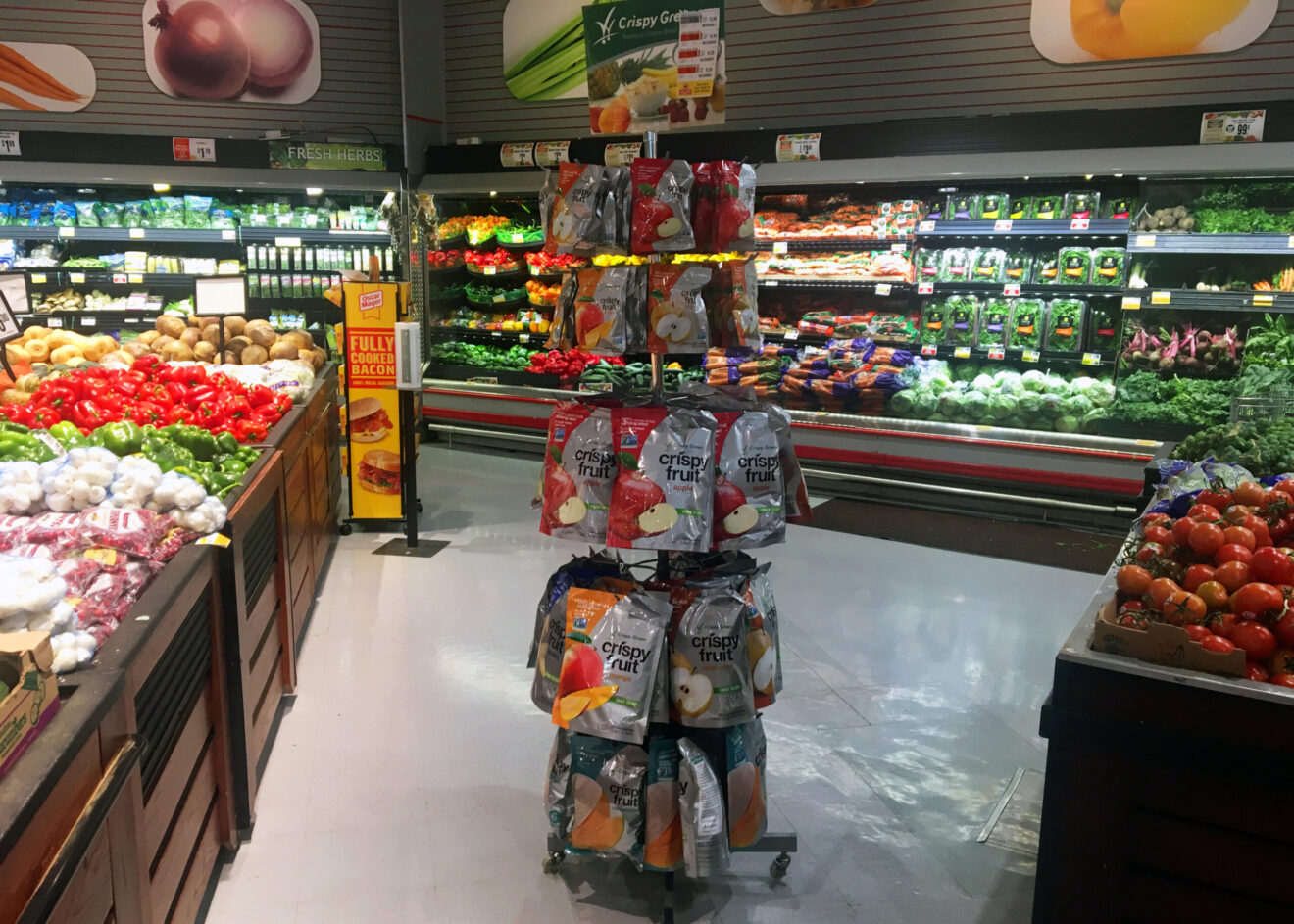This post is sponsored by Crispy Green.
Shopping the perimeter of the store is a habit of health-minded consumers, and Crispy Green has found success in merchandising its freeze-dried fruit products in the produce aisle. By strategically placing its products in a part of the store where shoppers have healthy eating on their minds, the maker of Crispy Fruit premium freeze-dried fruit snacks has become the No. 1 freeze dried fruit brand at retail, according to recent IRI data. We interviewed founder and President Angela Liu about how merchandising its products in the produce section gives the brand an advantage, how the brand communicates with customers and what’s in store for 2017.
Crispy Green is the No. 1 freeze-dried fruit brand at retail according to IRI data. How does Crispy Green distinguish itself from the competition?
Crispy Green is thrilled to have attained the No. 1 status. We attribute this achievement to our strong commitment to our brand vision, our unique marketing approaches and our uncompromised stand on our core values. From the start, we have been committed to providing high quality, nutritious and delicious snacks made with simple ingredients for consumers of all ages. We believe that the educated consumer is our best customer. We educate our consumers and retail partners about the freeze-drying process and its benefits, and engage with them regularly to continue improving and evolving our brand.
Have Crispy Green products always been merchandised in the produce section?
From the beginning, we have tried to merchandise our products in the produce section whenever possible. We believe that people who shop for produce are more interested in healthy eating. Also, as a new product, we can be spotted easily when placed in the produce section with our own rack. Freeze-dried fruit is a great substitute for fresh fruit, especially when fresh fruit is not in season or people are looking for fruit that is more portable and has a longer shelf-life.
How does positioning your products in the produce section give the brand an advantage?
The biggest advantage is visibility. As I mentioned before, by merchandising our products in the produce section (especially on the display rack we provide), it greatly increases the chances for customers to find the products. Most often, while consumers are looking for fresh produce, healthy eating is not far from their thoughts. Having our products positioned in the produce aisle helps to associate our products with fruit rather than candies or other unhealthy snacks. Essentially, we want shoppers to think of Crispy Fruit as another convenient fruit product with a much longer shelf-life to complement their fresh fruit purchases.
Retailers also have a definite advantage in merchandising Crispy Fruit in the produce department — mainly profitability. Based on internal sales data from customers we sell to, gross sales increased at least threefold when Crispy Green was merchandised in the produce section as opposed to the grocery snack aisle. Additionally, the retailer provides their customers with another great option to purchase when they are in the produce-shopping mindset.
Positioning Crispy Green products in the perimeter of the store puts the brand in front of consumers who are looking for healthy foods, but shoppers looking for fresh foods may not have packaged fruits on their radar. How do you communicate to shoppers that Crispy Green products are nutritious and retain the flavor of fresh fruits?
We communicate to shoppers on many levels. At the store level, we rely on our packaging to do the talking. We called our product Crispy Fruit and keep our messages simple and easy to read. By oversizing the Nutrition Facts panel, we let the facts speak for themselves. In the front panel, we use bright colors on a silver metallic color film with a large image of fresh fruit that jumps off the package to 1) attract attention and 2) convey health, flavor and advanced technology. We’ve had very positive feedback on our packaging, but are always refining to enhance our message and value proposition.
In addition to your successful sales and merchandising strategies, how else are you reaching your customers and ensuring you keep the Crispy Green brand at the forefront? What do you have planned for the brand heading into 2017?
Our Crispy Green customer is our most important asset! Therefore, we communicate with them on a regular basis to stay engaged and continue building upon this critical relationship. Through social media we are able to go to where our customers are and learn about what’s important to them. We then develop our integrated marketing campaigns and partnership programs to help drive our message and promote healthier snacking. To take it a step further, we have recently launched our consumer facing healthy lifestyle website, SmartLifebites.com. This consumer-centric platform will help us build a community that cares and shares Crispy Green’s value for healthy living. To increase the “edu-tainment” value of our new platform, we introduced a pair of new mascots — Chris B. Green & Chirp, who are going to help extend our engagement with our younger fans.
We’re very excited about 2017— we’re in the planning stages of our “New Year/Return to School” campaign that includes an extended partnership with Produce for Kids and their “Power Your Lunchbox” program. We have a number of fully integrated marketing campaigns planned for the rest of the year. Can’t wait to start the year out with a bang!
Angela Liu, president and founder of Crispy Green, has always been a true believer in the importance of living an active, healthy lifestyle. A chemist by trade, she discovered freeze dried Fuji apples during a trip to China and was immediately hooked. Inspired by her experience and her passion for great food and healthy eating, Liu took action and began marketing freeze-dried fruit snacks in the summer of 2005.
__________________________________________________
If you enjoyed this article, join SmartBrief’s email list for more stories about the food and beverage industry. We offer 17 newsletters covering the industry from restaurants to food manufacturing.
